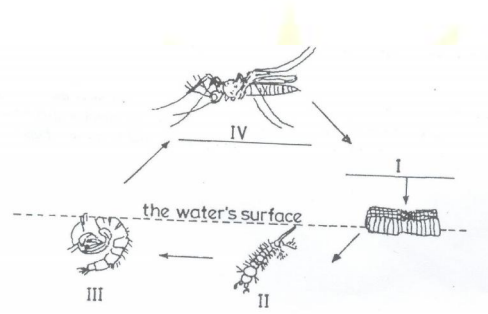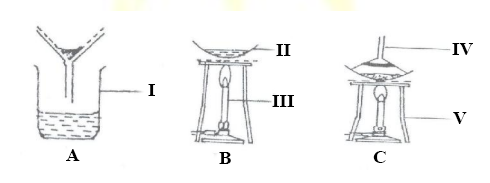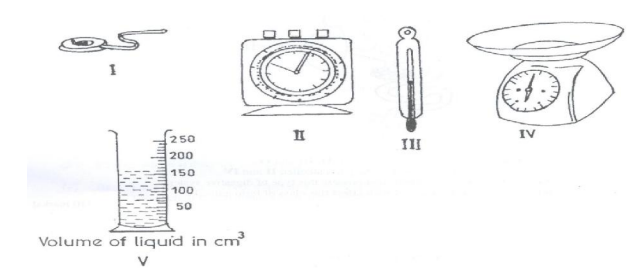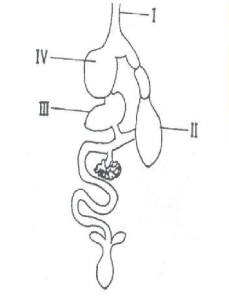1.
Which of the following type of teeth is used by mammals to tear food material?
Canines
Incisors
Molars
Premolars
2.
The eclipse formed when the moon comes between the sun and the earth is known as
annular eclipse
lunar eclipse
solar eclipse
total eclipse
3.
The element with the chemical symbol S is
silicon
silver
sodium
Sulphur
4.
The term leaching in soils refers to .....
accumulation of organic matter
decomposition of plant material
fixation of nitrogen
removal of soil nutrients by water
5.
Which of the following statements about plant cell is correct? It
does not have a nucleus
contains large vacuoles
is surrounded by the cell membrane only
does not have a definite shape
6.
An example of a derived quantity is
length
mass
temperature
volume
7.
Solid non-metals normally break into pieces when hammered because they are
brittle
ductile
lustrous
malleable
8.
Young rabbits are called
bunnies
cubs
fingerlings
kids
9.
Producers in an ecosystem are plants that
attract insects
feed on other plants
feed on dead materials
manufacture their own food
10.
The form of energy produced from the nucleus of an atom is termed
chemical energy
mechanical energy
nuclear energy
thermal energy
11.
Which of the following elements is a semi-metal?
Carbon
Nitrogen
Silicon
Sodium
12.
A system of farming that leads to continuous destruction of virgin forests is
mixed farming
mixed cropping
pastoral farming
shifting farming
13.
The by-products of respiration are
carbon dioxide and heat
carbon dioxide and water
oxygen and heat
oxygen and water
14.
Which of the following statements about a force are correct? It
I. is measured in newtons.
II. is measured in newton-metre.
III. can start a motion.
IV. can change the direction of a moving body.
I and II only
I and III only
I, III and IV only
I, II, III and IV
15.
Which of the following substances is a solid-gas mixture?
Lather
Bronze
Steel
Smoke
16.
Weeds on a school farm could be controlled by
handpicking
mowing
ploughing
tilling
17.
An example of a non-living tissue used in osmosis experiment is
cellophane
filter paper
potato
polythene
18.
Kerosene is poured on the surface of a pond in order to
make it unsafe for human consumption
make it safe for animal consumption
increase the surface tension
break the surface tension
19.
Which of the following processes is used to separate insoluble solids from liquids?
Crystallization
Evaporation
Filtration
Sublimation
20.
The process of removing unproductive poultry birds from a flock is referred to as
candling
culling
dehorning
drenching
21.
Which of the following pairs of diseases can be spread easily when food is exposed to houseflies?
Dysentery and malaria
Malaria and tuberculosis
Dysentery and cholera
Cholera and tuberculosis
22.
The pressure in fluids
acts differently in all directions
acts upwards at any point
decreases with depth
increases with depth
23.
Which of the following processes involve a change in the state of matter from liquid to solid?
Evaporation
Freezing
Melting
sublimation
24.
Which of the following food items contains the highest amount of dietary fiber?
Beans
Bread
Cabbage
Egg
25.
An example of a disease vector is
earthworm
liver fluke
tapeworm
tick
26.
Which of the following devices is made of semiconductor?
Capacitor
Inductor
Resistor
Transistor
27.
Which of the following statements about the properties of water are correct? It
I. is colourless and tasteless
II. is neutral to litmus paper
III. turns red litmus paper blue
IV. is a universal solvent
I and II only
I and III only
I, II and IV only
I, III and IV only
28.
The study of the soil profile of an area helps the farmer to
control weed growth
determine the soil temperature
determine the types of crop to grow
know the pesticides to use
29.
When a green leaf is placed in a test tube containing ethanol and heated over a water bath the leaf
becomes soft
changes colour to brown
changes colour to blue-black
is decolorized
30.
Which of the following source(s) of energy is/are renewable?
I. Solar
II. Crude oil
III. Wind
I only
I and II only
I and III only
I, II and III
31.
Which of the following substances is a compound?
Hydrogen
Nitrogen
Oxygen
Water
32.
A disease-causing organism that is most difficult to control in crop production is
bacterium
fungus
nematode
virus
33.
Which of the following organisms is/are multicellular?
I. Amoeba
II. Paramecium
III. Onion
I only
III only
I and III only
II and III only
34.
In electronic circuits, LEDs are used to indicate the absence or presence of
emitter and collector
electric current
p-n junction
voltage source
35.
Steel is an alloy of iron and
aluminum
carbon
silicon
gold
36.
Soil aeration could be improved through
mulching
irrigation
soil drainage
fertilizer application
37.
Which of the following pairs of structures are parts of the respiratory system of humans?
Fallopian tube and alveoli
Pharynx and esophagus
Trachea and alveoli
Trachea and duodenum
38.
Which of the following effects is not a result of illegal connection of electricity?
It can
lead to fire outbreak
lead to frequent power cut-off
increase the flow of current in the supply chain
cause damage to electrical appliance
39.
Which of the following statements about the scientific method is/are correct? It provides
I. logical procedure for arriving at knowledge
II. knowledge that can be verified
III. knowledge that can never be changed
I only
I and II only
I and III only
II and III only
40.
An entrepreneur's decision as to what to produce is a/an
co-ordinating function
organizing function
planning function
supervising function
(a)
The diagram below represents the stages in the life cycle of a mosquito.
Study the diagrams carefully and answer the questions that follow.

(i)
Name each of the stages labelled I, II, III and IV.
(ii)
State how stage II obtains oxygen.
(iii)
State two methods of controlling each of the stages labelled III and IV.
(b)
The diagrams below are different laboratory set-ups used in the separation of mixtures.
Study the diagrams carefully and answer the questions that follow.

(i)
Name each of the parts labelled I, II, III, IV and VI.
(ii)
Name the separation method represented by each diagram.
(iii)
Which of the set-ups is used to obtain clear water from muddy water?
(iv)
Which of the set-ups is used to obtain salt from salt solution?
(c)
The diagrams below show some instruments used in the laboratory.
Study the diagrams carefully and answer the questions that follow.

(i)
Identify each of the instruments labelled I, II, III, IV and V.
(ii)
State one use of each of the instruments labelled I, II, III and IV.
(iii)
Read and record the volume of the liquid in the instrument labelled V.
(d)
The diagram below shows the digestive system of a class of farm animals.
Study the diagram carefully and answer the questions that follow.

(i)
Name each of the parts labelled I, II, III and IV.
(ii)
State one function each of the parts labelled II and IV.
(iii)
Name two farm animals that possess this type of digestive system.
(iv)
Mention two diseases which affect this class of farm animals.
(a)
(i)
Name the two elements that combine to form water.
(ii)
Write a balanced chemical equation to show how the water is formed from the named elements.
(b)
State two ways of maintaining a balance in an ecosystem.
(c)
(i)
What is a fertile soil?
(ii)
State two factors that cause loss of soil fertility.
(d)
Classify the following items as magnetic or non-magnetic substance: wood, steel blade, rubber and glass jar.
(a)
(i)
What is germination of seed?
(ii)
State two conditions necessary for the germination of seed.
(b)
State four methods used in identifying farm animals.
(c)
Explain why it is easier to cut a piece of yam with a sharp knife than with a blunt knife.
(d)
State three differences between a metal and a non-metal.
(a)
(i)
What is debeaking?
(ii)
Give two reasons why debeaking in poultry birds is important.
(b)
(i)
A steel needle carefully placed on the surface of water floats. What type of force made the steel needle to float?
(ii)
Name three substances that could be added to the water to make the steel needle to sink.
(c)
(i)
Explain why gold is preferred to iron in the making of jewelleries.
(ii)
State one way of preventing rusting.
(d)
(i)
State two elements of climate.
(ii)
Name the equipment used to measure each of the elements stated in (i) above.
(a)
(i)
What is refraction of light?
(ii)
Sketch a diagram to show the path of a light ray when it travels from air to glass.
(b)
Explain why it is difficult to separate iron and sulphur mixture after strong heating.
(c)
(i)
Give two examples of digestive enzymes produced in humans.
(ii)
For each of the enzymes given in (i), name the part of the human body where the enzyme is produced.
(d)
List four methods of applying fertilizers to crops.
(a)
Consider the substances listed below: carbon dioxide, gold, bronze, iron, oxygen and ink. From the list, select the substance that:
(i)
supports burning;
(ii)
is used as jewellery;
(iii)
is used for making statues.
(b)
(i)
Name two diseases associated with the circulatory system of humans.
(ii)
State one way of preventing each of the diseases named in (i).
(c)
Give two examples of each of:
(i)
major plant nutrients;
(ii)
minor plant nutrients.
(d)
(i)
State two properties of a good thermometric liquid.
(ii)
Give two examples of a good thermometric liquid.